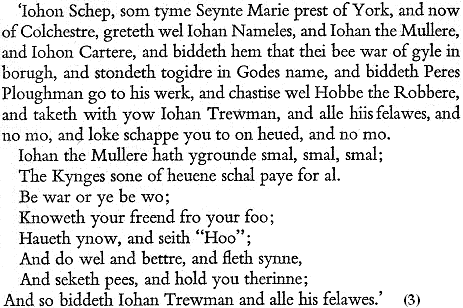The Many Robin Hoods 3
In the fourteenth century rogues and thieves were sometimes described as ‘Robert’s men’. In an Act of parliament in 1331, the phrase was included which referred to the ‘robberies, homicides and felonies done in these times by people called Roberdesmen, Wastours and Drahlacche (Drawlatch)’.(1) Robert Lynley discovered another record of men who used the name Roberdesman. Robin Hood, Robert’s knaves, Robert the robber, and others of the name Robert and Robin, appear in Piers Plowman. Holt believed that the author (William Langland) must have picked up much of what he knew of Robin Hood and Robert the Robber in the taverns of London. Pierce the Ploughmans Crede, is an anonymous verse of the late fourteenth century, influenced by Langland and the writings of Wycliff, in which the Franciscan talks critically of the Carmelites:
In The Institutes of the Laws of England, (1628-1634) Sir Edward Coke (1552-1634) chief justice of the king’s bench of James I mentions, ‘What this Robin Hood was that hath raised a name to these kind of men called Roberdsmen, his followers’. William Blackstone, (1723-1780) an English judge, jurist, and legal scholar, in his Commentaries on the Laws of England (1765-1769) mentions, ‘persons in disguise….. who seem to have resembled the Roberdsmen, or followers of Robert Hood’. Sporting Magazine of 1796: Viii 76. ‘men of his lawless profession were from him called Roberdsmen’.
The words ‘English hobbe’ are written in The Statutes of Kilkenny (1367). Hobbe the Robber appears in a famous letter which the priest John Ball sent to the leaders of the commons in Essex, who were involved in the Peasants Revolt of 1381. Ball encourages the commons, urging them to stand ‘togidre in Godes name’, to permit Piers Plowman to do his work, and to ‘chastise wel Hobbe the Robbere’, and to observe one leader only, rather than going their own ways. He refers to himself and his fellow conspirators in code. He is ‘Johon Schep’; others include ‘Johan Nameles’, ‘Johan the Mullere’, ‘Johon Cartere’, and ‘Johan Trewman’. This letter was supposedly found later, in the pocket of a man who was to be hanged for his part in the rebellion:
John Ball confessed that he had written this letter and sent it to the commons, and he admitted writing many others. He was hanged, drawn and beheaded at St Albans on 15 July in the king’s presence; and the four quarters of his corpse were sent to four cities in the kingdom. There was another letter by ‘Jakke Carter’. Hobbe the Robber has been identified as the treasurer, Robert Hales, whom the peasants executed on Tower Hill. This was pointed out by Holt, who has suggested another possibility, Sir Robert Belknap, chief justice of the king’s bench, who was carrying out a commission of trailbaston in Essex when the peasants caught him. Holt alternately suggested that Hobbe the Robber may simply be another folk version of Robert the Robber as the archetypal criminal(4) This is similar to the remark by Dobson, who thought it ‘unlikely that Hobbe the Robbere should be identified, as is often done, with Treasurer Robert Hales, rather than the common late medieval personification of robbery’.(5) A group of malefactors assaulted William, a former servant of John of Garton, at Beverley. Some of these men apparently made a rhyme in English, (which mentions Hobbe and John) and had the rhyme recited at Beverly and Hull, and other places in Yorkshire, in 1392.
1. Edward III, (an. reg. 5, c.14). Robartes men, or Robertsmen, were a set of lawless vagabonds, notorious for their outrages when Piers Plowman was written. William of Nassyngton says that they tried the latches of people’s doors, contrived to get into houses, and then extorted money either by telling some lying tale or playing the bully. (Skeat,Piers the Plowman, Vol. II, p. 7)
2. Pierce the Ploughmans Crede, W. W. Skeat, (Early English Text Society), 1867.
3. The Peasants Revolt of 1381, R. B. Dobson, 1970, p. 381.
4. Holt, Robin Hood, p. 157.
5. The Peasants Revolt of 1381, R. B. Dobson, 1970, p. 379.


|

